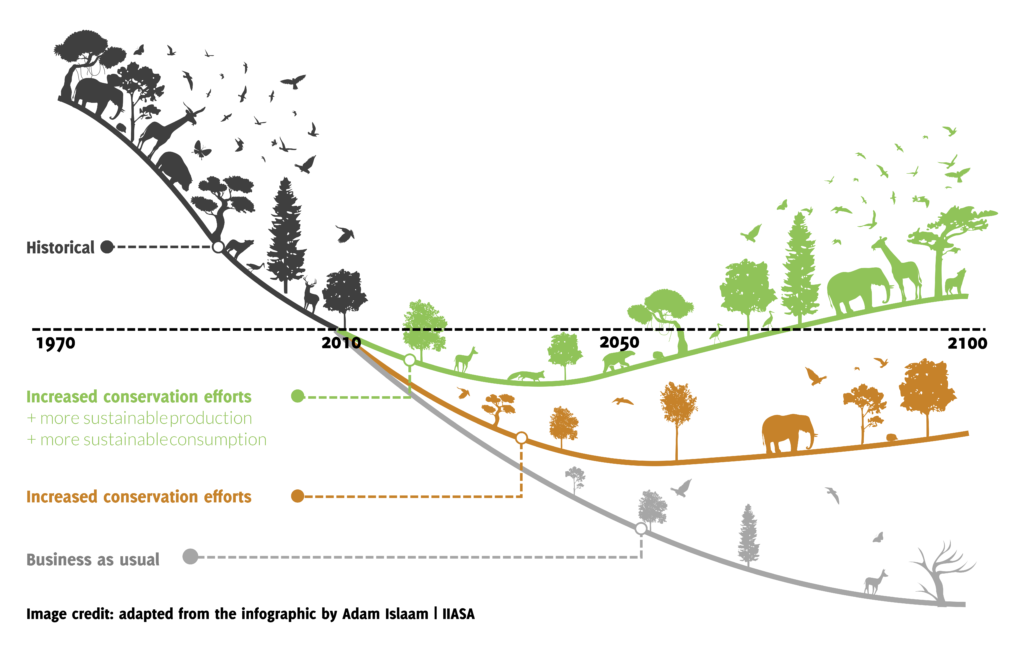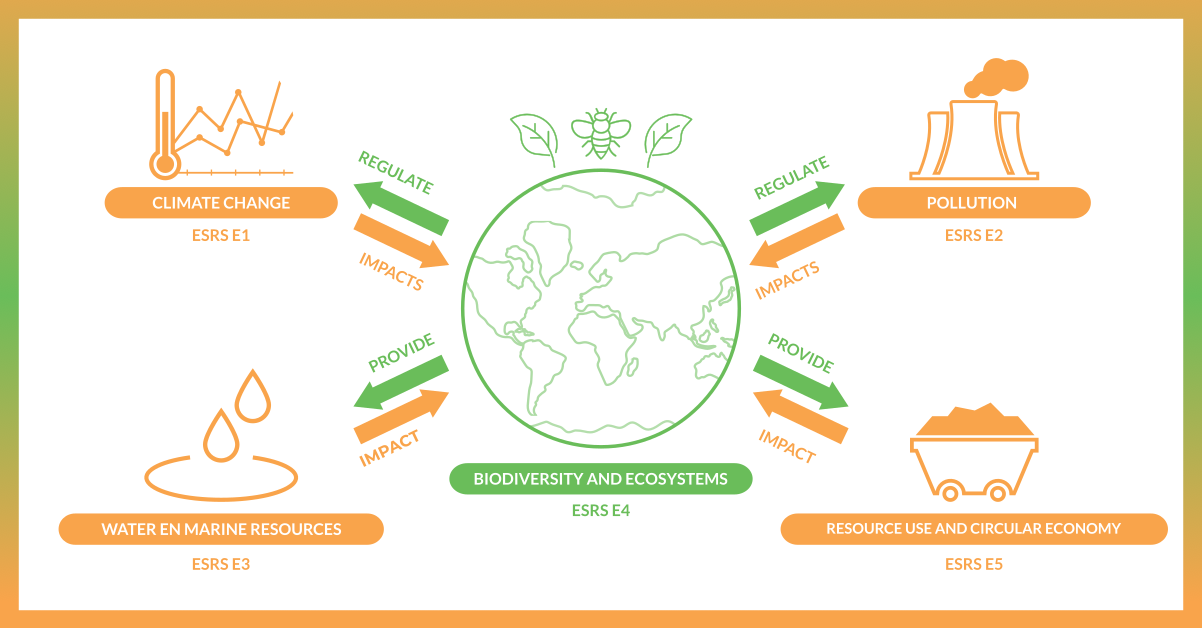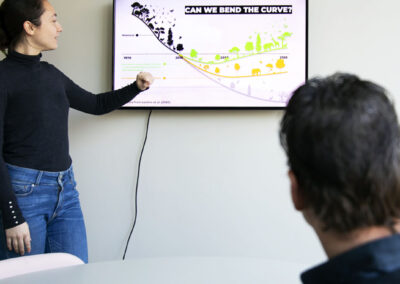Is biodiversity a material topic for your organisation?
Are you working with the CSRD guidelines and want to find out if and how you comply with the environmental standard? This can be done with our Impact & Dependency Scan, where we carefully assess together how your operations and value chain relate to biodiversity. This way, you can determine whether biodiversity is material to your organization.
Perhaps you are wondering whether biodiversity really affects your operations. Our answer to that is a resounding ‘Yes.’ Nature and biodiversity (the variety of life on Earth at all its levels, from genes to ecosystems) form the backbone of our economy. More than half of our global economy is directly dependent on our natural ecosystem. (Source: World Economic Forum (2022) The Global Risk Report).

A matter of awareness
Our society cannot survive let alone thrive without ecosystem services such as clean air, clean water, a clean and fertile soil, and natural resources. These services can only persist if our biodiversity is maintained. The relationship between your production or value chain and biodiversity is a fact. Sometimes very visible and logical, sometimes unexpected. Unfortunately, biodiversity is declining rapidly, due to the destruction of habitats, the overconsumption of natural resources, pollution, and climate change. We are collectively responsible and each have a role to play in this biodiversity crisis. If you want to take an initial exploratory step and discover how biodiversity affects your organization, you can do so during an Awareness Workshop. In a smaller or larger context, you can easily get acquainted with biodiversity.

Biodiversiteit: double materiality
Within the CSRD, three themes are addressed: environmental, social, and governance. Biodiversity and ecosystems (ESRS E4) are part of the environmental theme, along with topics such as climate change (ESRS E1) and pollution (ESRS E2). The European Commission introduced the term ‘double materiality.’ It involves investigating the extent to which you depend on a topic and the extent to which you impact that topic. If either or both are significant, the topic qualifies as a material theme according to the CSRD. Biodiversity is essentially always doubly material, due to its undeniable dependence on what the Earth provides. You can limit your polluting emissions, but in any case, biodiversity and ecosystems regulate those emissions, and conversely, changing emissions affects biodiversity. Engaging with biodiversity is, therefore, a broad and comprehensive approach to sustainability.

Getting started
How do you get started? How do you make clear where in your chain and operations there is double materiality in terms of biodiversity? It may seem like a complex task, but fortunately, there are good methods available. We highlight two:
ACT-D
The overarching ACT-D framework guides companies through various tools, frameworks, and initiatives available in the market to work with nature. This is done through the steps ‘Assess,’ ‘Commit,’ ‘Transform,’ and ‘Disclose.’
LEAP
The Taskforce for Nature-related Financial Disclosure offers LEAP, a concrete approach for organizations looking to map their interactions with nature and determine a nature strategy. LEAP stands for Locate, Evaluate, Assess, and Prepare.
In our Impact & Dependency Scan, we also use such methods. You don’t have to figure it all out yourself but can thoroughly examine your business processes with us during such a scan. After the scan, you’ll have a clear and well-founded report that answers where in your chain the dependence on and impact on biodiversity are significant. This makes taking next steps much easier. You’ll soon know which levers to pull and can make other (better) choices. This way, you comply with the CSRD guidelines and proactively identify potential risks to your business continuity. You can even turn around your negative impact on biodiversity and contribute to more species richness.
Example from practice
We have already conducted an Impact & Dependency Scan for various companies, including funeral insurer DELA. DELA had performed a materiality analysis with the assistance of TOSCA (a sustainability reporting agency). In this process, DELA engaged with various stakeholders such as policyholders, suppliers, and regulators. Together, they assessed which topics were important and material for DELA. Stakeholders identified biodiversity as important, leading DELA to further investigate: How do we relate to biodiversity? Due to our expertise in ecology and biodiversity, TOSCA asked us to conduct the scan.
How we did it
We focused on the outdoor areas of DELA and the major material flows within their value chain, including coffins, flower bouquets, and products like coffee and tea. Let’s take a look at the coffins. DELA primarily uses pine wood from Sweden and Finland for this purpose. So, there is already a change in land use because a production forest is not a natural forest: it is created by humans. Moreover, it is customary in Scandinavian countries to clear portions of production forests at once (clearcutting). This suddenly eliminates a part of the habitat for various plant and animal species, putting local biodiversity at risk. The question is: To what extent are you dependent on pine wood, and what impact does your company have? For example, you can choose to source your wood from places where harvesting is done through thinning, preserving habitats. Similarly, you can examine the cotton needed for the coffin linings. Cotton cultivation is water-intensive, and extracting water from a river is often necessary. If you purchase cotton from an area already facing extreme drought, that river may completely dry up. In this case, staying away from that area is crucial because extracting more water is harmful to the environment and poses a risk to your own business model. So, you are both dependent and responsible.
Assessing risks
For each material flow, we use the WWF Biodiversity Riskfilter to outline the impact a raw material has on the area and the risks it poses to biodiversity there. The tool helps identify biodiversity hotspots and indicates which risk areas should be avoided. It’s important to note that obtaining precise insights becomes easier when you know exactly where all your raw materials come from. However, tracing every component within your chain back to its origin is not always straightforward. Our raw materials are no longer sourced from nearby neighbours or a village down the road; industrialization and globalization have made our production flows complex and often opaque. The more transparent your chain (upstream-direct activities-downstream), the clearer and more precise the understanding of the consequences of your choices for both your business and biodiversity. Often, the most significant impact is found upstream (in procurement).

Example of an impact wheel with impact scores per upstream activity.
Visuals full of insights
Based on intensity (low or high?), scale (local or global?), and remediability (can the impact be restored or not?), we assign impact scores. These scores are incorporated into a wheel that, at one glance, reveals the critical areas. These clear visuals show which parts within your chain and operations warrant further investigation. They also assist in prioritizing your actions. Once you identify the bottlenecks, you can proceed to a risk and opportunity scan. Taking it a step further involves creating a transition plan, where you explore how to avoid, minimise, restore, or offset negative impacts on biodiversity.
From intake to substantiated report
Are you interested in an Impact & Dependency Scan? We begin with an intake interview, where we get to know each other and discuss the data we require. You then have time to provide that data. We will analyse and evaluate the data using recommended tools and methods, creating a draft of our findings. In a workshop, we share the initial results. We discuss and refine the results based on your experiences and insights. Finally, we deliver a comprehensive report, including visuals.
Want to learn more? Check out our services: Awareness Workshop and Impact & Dependency Scan.

